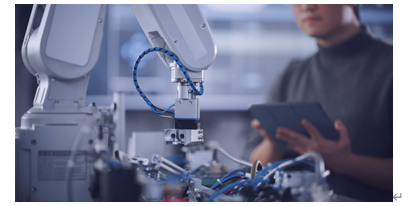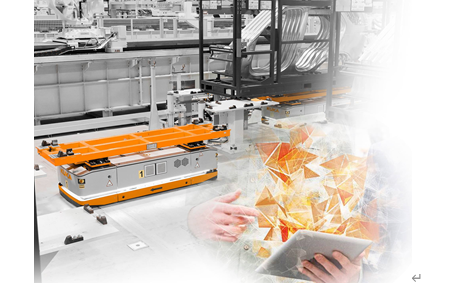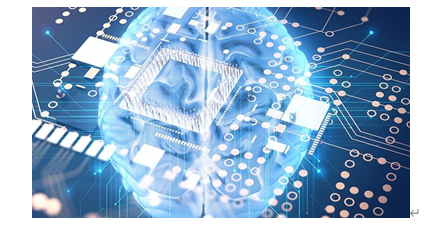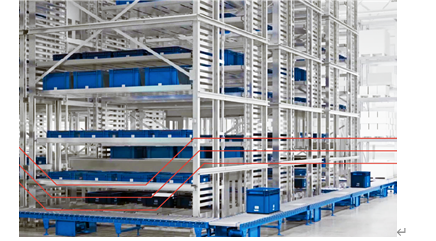
 HOME >> News >> Industry News
HOME >> News >> Industry News
With the continuous advancement of technology, all industries are beginning to explore and adopt innovative technologies to improve efficiency, optimize work processes and provide better customer experience. In this wave of change, AI has gradually emerged as the key technology to lead the change. In the field of intralogistics in particular, AI is reshaping how the entire field operates at an unprecedented rate. Logistics, as the core part of the modern enterprise, is seeking more efficient, faster and more accurate methods to meet the growing needs of the market. With the advent of AI technology, we now have the opportunity to explore these deep-seated changes and anticipate future possibilities. The purpose of this paper is to explore the changing effects of AI in internal logistics and the implications of these effects for enterprises and the logistics industry as a whole.

(1) Intelligent prediction
Definition: AI predicts future logistics needs by analyzing historical data, such as inventory demand, delivery volume, and time.
Detailed interpretation:
Demand forecasting: Based on historical order data, AI can predict future sales trends and help companies predict which items will be more in demand in the coming period.
Inventory management: While traditional inventory management often relies on experience and intuition, AI can provide more accurate inventory recommendations to ensure that the warehouse is neither overstocked nor out of stock.
Supply chain optimization: By analyzing data from multiple supply chain nodes, AI can predict potential supply chain disruptions or delays and make adjustments accordingly in advance.
(2) Hands-on sorting
Definition: AI-driven picking machines can pick goods by itself, quickly and accurately.
Detailed interpretation:
Efficiency improvement: Traditional picking is often inefficient and is affected by fatigue and inattention. However, machines can work 24/7 without interruption, which has raised the efficiency of selection.
Reduce errors: AI algorithms can ensure that machines accurately identify and pick goods, significantly reducing errors caused by human errors.
Flexibility: With the application of machine learning technology, picking machines can quickly learn new picking tasks and respond to changes in the type and layout of goods in the warehouse.

(3) Intelligent path planning
Definition: AI technology enables the machines and transport systems in the warehouse to calculate the optimal path in real time.
Detailed interpretation:
Reduce collisions: By analyzing the location and movement path of objects in the warehouse in real time, AI can predict and avoid potential collisions and improve safety.
Save time: AI algorithm can quickly calculate the shortest path from point A to point B, shortening the delivery time of goods.
Energy efficiency: The optimal path not only saves time, but also reduces the energy consumption of the machine and transport system, thus reducing operating costs.
(4) Real-time monitoring and optimization
DEFINITION: Through sensors and AI analytics, logistics operations can be monitored in real time and optimized when needed.
Detailed interpretation:
Real-time feedback: The AI system can analyze the operational data of the warehouse in real time to provide management with immediate performance feedback.
Manipulation optimization: When inefficiencies or potential problems are detected, AI systems can automatically adjust operational strategies to ensure a smooth logistics process.
Early warning system: When the system detects potential problems or risks, AI can issue early warning to help management make timely decisions.
(5) Predictive maintenance
AI can predict when a device is likely to fail or need maintenance by analyzing its performance data and performance metrics.
Detailed interpretation:
Advance detection: Traditional maintenance is often based on the working time of the device or after a failure occurs. AI can analyze the device's work data, identify potential abnormal patterns, and detect possible problems in advance.
Extended equipment life: Through predictive maintenance, equipment problems can be solved before they become problems, extending equipment life and reducing maintenance costs.
Reduce downtime: Because the maintenance needs of equipment can be predicted in advance, enterprises can make maintenance plans in advance to reduce unexpected downtime and ensure the continuity of logistics operations.
(6) Augmented Reality (AR)
Definition: Combined with AR technology, AI can provide real-time guidance and information for workers.
Detailed interpretation:
To improve operational efficiency: Through AR glasses or other devices, workers can obtain information such as cargo location and picking path in real time to complete tasks faster.
Reduce training time: New employees can get real-time operation guidance through the AR system, reducing their training time and quickly.
Enhanced security: The AR system can provide safety advisories and warnings for workers, such as alerting them to moving machines or other potential hazards.
(7) the degree of personalized logistics solutions
Definition: AI can provide personalized logistics services according to the specific needs and preferences of customers.
Detailed interpretation:
To meet individual needs: for specific customers or orders, AI can provide customized logistics cases, such as specific delivery time, packaging type, etc.
To improve customer satisfaction: By meeting the individual needs of customers, enterprises can improve customer satisfaction and loyalty.
Real-time feedback: AI systems can collect and analyze customer feedback in real time to help companies better understand customer needs and optimize them.
(8) the main mobile machine
Definition: AI-powered mobile machines can perform various tasks independently in the warehouse.
Detailed interpretation:
Flexible deployment: These machines can be deployed according to real-time logistics requirements without complex programming or settings.
Collaborative Work: Multiple machines can work together to perform more complex tasks, such as moving a piece of goods.

Work with: These machines are designed to be safe and can work with people to improve the overall logistics efficiency of the work.
(9) Customer service and holding
Definition: AI-driven customer service systems, such as chat machines, can provide 24/7 support to customers.
Detailed interpretation:
Immediate response: Compared with the traditional customer service hotline, AI system can provide immediate response and improve customer satisfaction.
Handle common problems: Most customer problems are common, and more complex problems can be handled by the AI system.
Data analytics: AI systems can analyze customer queries and feedback to provide valuable market insights.
(10) Quality control
Definition: With advanced image recognition and data analysis technology, AI can detect quality problems of goods by itself.
Detailed interpretation:
Manually-actuated inspection: Traditional quality inspection often relies on AI inspection, which is prone to omission or misjudgment. The AI system can continuously scan every product to ensure that every detail is up to standard.
Rapid response: Once an AI system detects a quality problem, it can take action, such as removing the problem product from the production line, to reduce the output of substandard products.
Trend analysis: By analyzing the detected problems, the AI system can identify possible production defects or machine problems and help enterprises take timely measures to avoid further losses.
(11) Data-driven decision-making
Definition: AI can provide real-time, data-driven advice to logistics decision makers through data analysis.
Detailed interpretation:
Deep insight: AI systems can extract valuable information from a large amount of logistics data, such as which processes are inefficient and which equipment may have problems.
Real-time recommendations: Based on data analysis, AI systems can provide real-time recommendations to decision makers, such as how to optimize processes and whether new equipment needs to be purchased.
Predicting the future: In addition to analyzing current data, AI can also predict future logistics needs, potential problems, etc. based on historical data to help companies make more long-term plans.

(12) Security and monitoring
Definition: AI technology can improve the safety of warehouse and logistics, and avoid the occurrence of accidents through real-time monitoring.
Detailed interpretation:
Adequate performance analysis: AI can analyze the performance of AI workers and AI machines in the warehouse to identify possible security risks, such as improper handling and abnormal machine movements.
Alert system: When the AI system detects a potential security risk, it can automatically issue a warning to alert the user or adjust the user's performance.
Post-event analysis: If an accident occurs, the AI system can help the enterprise to make post-event analysis to find out the cause of the accident and take measures to avoid the recurrence of similar accidents.
Generally speaking, the changes brought about by AI in internal logistics are not only technical changes, but also a process of business transformation, which affects every link and decision of the enterprise. From optimizing operations and improving efficiency to providing a more personalized customer experience, the impact of AI is nowhere to be found.
However, at the same time, it also brings new challenges, such as data security, the cooperative relationship between people and machines, and the continuous updating and learning of technology. To take full advantage of the opportunities that AI offers, business and industry leaders must keep an open mind to learn and adapt, while also being mindful of potential risks and challenges.
In the end, those enterprises that dare to embrace change, continue to innovate and deeply explore the potential of AI will stand out in the future logistics field and lead the way forward.